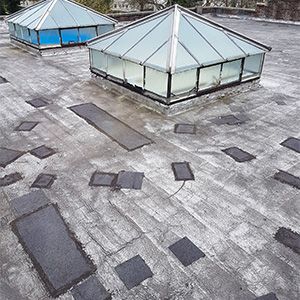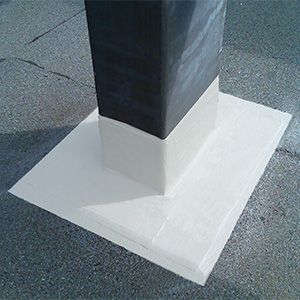Cold liquid applied waterproofing membranes offer versatility to waterproofing a flat roof. All roofs will have numerous details including upstands, roof penetrations and outlets for drainage. Many larger roofs incorporate edge protection, walkways, balustrades and roof safety line fixings. There may also be significant amounts of plant, communication towers, aerials and increasingly PV panels that require consideration when waterproofing a flat roof.
Why are Roofing details vulnerable to water ingress?
Here at Triflex we carry out hundreds of flat roof condition surveys every year. We understand that most often the point of water ingress for a flat roof is at a roof detail. But why is that?
Traditional roof waterproofing systems maybe of a sheet construction, which can be difficult to form around complex shapes and upstands. Often the installation involves the overlapping of such sheets to cover the form of the roofing details which is difficult and time consuming and fiddly. Laps and seams introduce a point of weakness in the waterproofing that is inherently more susceptible to water ingress as they are dependent on adequate bonding between the layers. Cold applied liquid waterproofing is seamless and homogenous meaning this risk is negated by its very form.
Waterproofing roof details may also make use of completely different materials to those which are used for the main expanse of flat roof. Its not uncommon to see a mixture of asphalt and felt, or single ply membrane with patch repairs of a different type. This means that the materials will have different properties including varying coefficient’s of expansion depending on thermal conditions. Simply put, they behave differently to each other depending on the external temperature. If materials that are bonded to each other move at different rates depending on the temperature, then cracks and splits can readily occur.
Triflex cold liquid applied waterproofing utilise technologically advanced PMMA resins. With highly elastomeric and flexible properties they can easily accommodate movement. Certified and tested for dynamic crack bridging to the highest standard, they deliver peace of mind.
Cold liquid applied waterproofing can be used solely for details as a stand-alone solution, or as part of a whole roof waterproofing system. Cold liquid applied waterproofing can meet the challenges of multiple details forms. In addition there are formulations that can meet unique details too. With thixotropic formulas, domed or near vertical surfaces can be waterproofed without the concern for slumping or run off. Hard to reach areas can be waterproofed with formulations that include a fibre reinforcement in the liquid waterproofing itself, that is simply applied by brush. And for some penetrations such as balustrade fixings a flowable, pourable solution can be used with a former to provide a waterproof sealant solution.
Of course, where bonding to another materials the compatibility of the cold liquid applied waterproofing with the substrate must be robust. Triflex PMMA resin based waterproofing systems are highly compatible with nearly every substrate type. With some 6500 substrates tested, from single plys, EPDM and TPO to asphalt, metal and timber the cold liquid applied waterproofing can be used to overlay a host of existing waterproofing at details or main expanse of flat roof.


